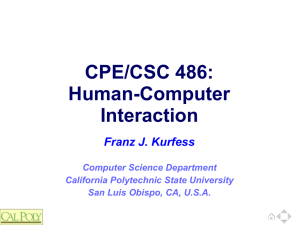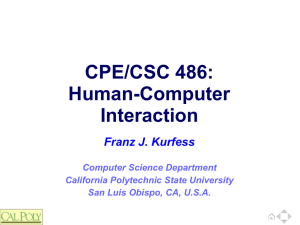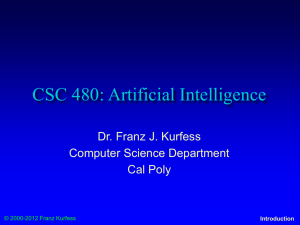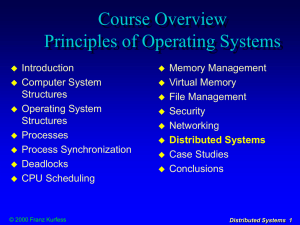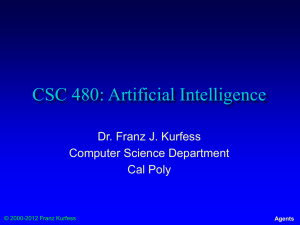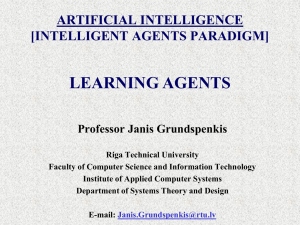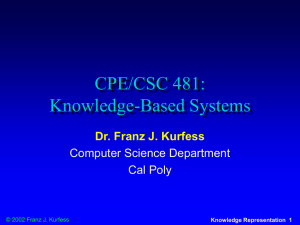Learning
advertisement
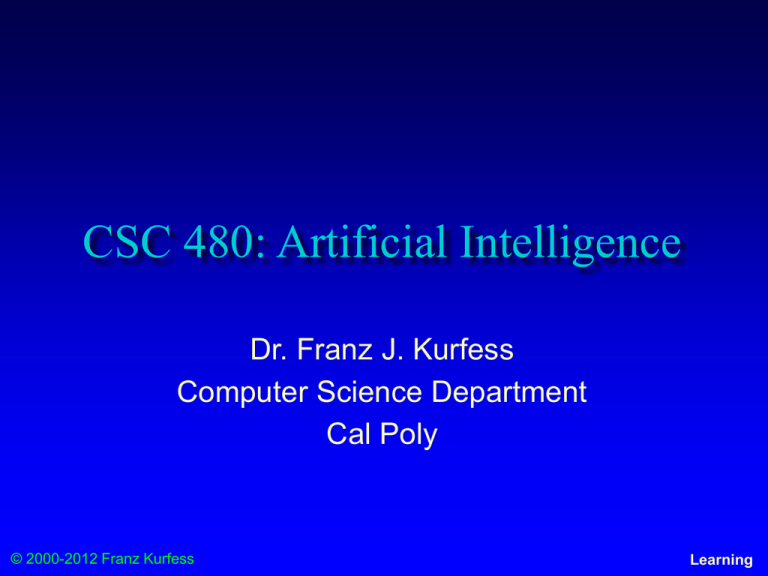
CSC 480: Artificial Intelligence Dr. Franz J. Kurfess Computer Science Department Cal Poly © 2000-2012 Franz Kurfess Learning Logistics - Nov. 15, 2012 ❖ AI Nugget presentations scheduled Section 1: Forrest Reiling: Interaction between Humans and Machines Trevor DeVore: AI in Aerial Vehicles (delayed to Nov. 15 or 20) Section 3: Steve Shenouda: Simulated Therapists (??) Vansteenwyk, Donald W.: Crosswords and Computers (delayed from Nov. 6) Kane Carroll: Facial Recognition Software (delayed from Nov. 6) John Biddle: IBM's Watson, the Jeopardy! Playing Robot (delayed from Nov. 6) Steve Choo: AI and Space Exploration (standby starting Nov. 15) ❖ Project ❖ Quiz ❖ Labs ❖ Lab 9 (Decision Tree Learning) Lab 10 (AI and Humor) A3 Competitions optional; let me know if you’re planning to submit something © Franz J. Kurfess 2 Course Overview Introduction Knowledge Intelligent Agents Search problem solving through search informed search Games games as search problems © 2000-2012 Franz Kurfess and Reasoning reasoning agents propositional logic predicate logic knowledge-based systems Learning learning from observation neural networks Conclusions Learning Chapter Overview Learning Motivation Learning Objectives Learning from Observation Learning Agents Inductive Learning Learning Decision Trees Computational Learning Theory Probably Approximately Correct (PAC) Learning © 2000-2012 Franz Kurfess in Neural Networks Neurons and the Brain Neural Networks Perceptrons Multi-layer Networks Applications Important Concepts and Terms Chapter Summary Learning Bridge-In “knowledge infusion” is not always the best way of providing an agent with knowledge impractical,tedious incomplete, imprecise, possibly incorrect adaptivity an agent can expand and modify its knowledge base to reflect changes improved through performance learning the agent can make better decisions autonomy without learning, an agent can hardly be considered autonomous © 2000-2012 Franz Kurfess Learning Motivation learning is important for agents to deal with unknown environments changes the capability to learn is essential for the autonomy of an agent in many cases, it is more efficient to train an agent via examples, than to “manually” extract knowledge from the examples, and “instill” it into the agent agents capable of learning can improve their performance © 2000-2012 Franz Kurfess Learning Objectives be aware of the necessity of learning for autonomous agents understand the basic principles and limitations of inductive learning from examples apply decision tree learning to deterministic problems characterized by Boolean functions understand the basic learning methods of perceptrons and multi-layer neural networks know the main advantages and problems of learning in neural networks © 2000-2012 Franz Kurfess Learning Learning an agent tries to improve its behavior through observation, reasoning, or reflection learning from experience memorization of past percepts, states, and actions generalizations, identification of similar experiences forecasting prediction of changes in the environment theories generation of complex models based on observations and reasoning © 2000-2012 Franz Kurfess Learning Learning from Observation Learning Agents Inductive Learning Learning Decision Trees © 2000-2012 Franz Kurfess Learning Learning Agents based on previous agent designs, such as reflexive, model-based, goal-based agents those aspects of agents are encapsulated into the performance element of a learning agent a learning agent has an additional learning element usually used in combination with a critic and a problem generator for better learning most agents learn from examples inductive learning © 2000-2012 Franz Kurfess Learning Learning Agent Model Performance Standard Sensors Critic Feedback Changes Learning Element Knowledge Performance Element Learning Goals Problem Generator Agent Effectors Environment © 2000-2012 Franz Kurfess Learning Forms of Learning supervised an agent tries to find a function that matches examples from a sample set learning each example provides an input together with the correct output a teacher provides feedback on the outcome the teacher can be an outside entity, or part of the environment unsupervised the agent tries to learn from patterns without corresponding output values reinforcement learning learning the agent does not know the exact output for an input, but it receives feedback on the desirability of its behavior the feedback can come from an outside entity, the environment, or the agent itself the feedback may be delayed, and not follow the respective action immediately © 2000-2012 Franz Kurfess Learning Feedback provides information about the actual outcome of actions supervised learning both the input and the output of a component can be perceived by the agent directly the output may be provided by a teacher reinforcement feedback concerning the desirability of the agent’s behavior is availab not in the form of the correct output may not be directly attributable to a particular action learning feedback may occur only after a sequence of actions the agent or component knows that it did something right (or wrong), but not what action caused it © 2000-2012 Franz Kurfess Learning Prior Knowledge background knowledge available before a task is tackled can increase performance or decrease learning time considerably many learning schemes assume that no prior knowledge is available in reality, some prior knowledge is almost always available but often in a form that is not immediately usable by the agent © 2000-2012 Franz Kurfess Learning Inductive Learning to find a function h (the hypothesis) that approximates a set of samples defining a function f tries the samples are usually provided as input-output pairs (x, f(x)) supervised learning method relies on inductive inference, or induction conclusions are drawn from specific instances to more general statements © 2000-2012 Franz Kurfess Learning Hypotheses finding a suitable hypothesis can be difficult the function f is unknown, it is hard to tell if the hypothesis h is a good approximation since hypothesis space describes the set of hypotheses under consideration the e.g. polynomials, sinusoidal functions, propositional logic, predicate logic, ... the choice of the hypothesis space can strongly influence the task of finding a suitable function while a very general hypothesis space (e.g. Turing machines) may be guaranteed to contain a suitable function, it can be difficult to find it Ockham’s razor: if multiple hypotheses are consistent with the data, choose the simplest one © 2000-2012 Franz Kurfess Learning Example Inductive Learning 1 f(x) input-output pairs displayed as points in a plane the task is to find a hypothesis (functions) that connects the points x © 2000-2012 Franz Kurfess either all of them, or most of them various performance measures number of points connected minimal surface Learning Example Inductive Learning 2 f(x) hypothesis is a function consisting of linear segments fully incorporates all sample pairs x © 2000-2012 Franz Kurfess goes through all points very easy to calculate has discontinuities at the joints of the segments moderate predictive performance Learning Example Inductive Learning 3 f(x) hypothesis x © 2000-2012 Franz Kurfess expressed as a polynomial function incorporates all samples more complicated to calculate than linear segments no discontinuities better predictive power Learning Example Inductive Learning 4 f(x) hypothesis is a linear functions does not incorporate all samples extremely easy to compute low predictive power x © 2000-2012 Franz Kurfess Learning Learning and Decision Trees based on a set of attributes as input, predicted output value, the decision is learned is called classification learning for discrete values regression for continuous values it Boolean or binary classification output values are true or false conceptually the simplest case, but still quite powerful making decisions a sequence of test is performed, testing the value of one of the attributes in each step when a leaf node is reached, its value is returned good correspondence to human decision-making © 2000-2012 Franz Kurfess Learning Boolean Decision Trees compute yes/no decisions based on sets of desirable or undesirable properties of an object or a situation each node in the tree reflects one yes/no decision based on a test of the value of one property of the object the root node is the starting point leaf nodes represent the possible final decisions branches are labeled with possible values learning aspect is to predict the value of a goal predicate (also called goal concept) the a hypothesis is formulated as a function that defines the goal predicate © 2000-2012 Franz Kurfess Learning Terminology example or sample describes the values of the attributes and the goal a positive sample has the value true for the goal predicate, a negative sample false sample set collection of samples used for training and validation training the training set consists of samples used for constructing the decision tree validation the test set is used to determine if the decision tree performs correctly © 2000-2012 Franz Kurfess ideally, the test set is different from the training set Learning Restaurant Sample Set Example X1 X2 X3 X4 X5 X6 X7 X8 X9 X10 X11 X12 Attributes Goal Exam Alt Bar Fri Hun Pat Price Rain Res Type Est WillWait Yes Yes No Yes Yes No No No No Yes No Yes No No Yes No No Yes Yes No Yes Yes No Yes No No No Yes Yes No No No Yes Yes No Yes © 2000-2012 Franz Kurfess Yes Yes No Yes No Yes No Yes No Yes No Yes Some Full Some Full Full Some None Some Full Full None Full $$$ $ $ $ $$$ $$ $ $$ $ $$$ $ $ No No No No No Yes Yes Yes Yes No No No Yes No No No Yes Yes No Yes No Yes No No French Thai Burger Thai French Italian Burger Thai Burger Italian Thai Burger 0-10 30-60 0-10 10-30 >60 0-10 0-10 0-10 >60 10-30 0-10 30-60 Yes No Yes Yes No Yes No Yes No No No Yes X1 X2 X3 X4 X5 X6 X7 X8 X9 X10 X11 X12 Learning Decision Tree Example Patrons? No EstWait? Yes Hungry? Yes Bar? No Yes Alternative? No Alternative? Yes Walkable? Yes Driveable? Yes © 2000-2012 Franz Kurfess No To wait, or not to wait? Yes No Learning Decision Tree Exercise Formulate a decision tree for the following question: Should I take the opportunity to eliminate a low score in an assignment by doing an extra task? some possible criteria need for improvement amount of work required deadline other obligations © 2000-2012 Franz Kurfess Learning Expressiveness of Decision Trees decision trees can also be expressed in logic as implication sentences in principle, they can express propositional logic sentences each row in the truth table of a sentence can be represented as a path in the tree often there are more efficient trees some functions require exponentially large decision trees parity function, majority function © 2000-2012 Franz Kurfess Learning Learning Decision Trees problem: find a decision tree that agrees with the training set trivial solution: construct a tree with one branch for each sample of the training set works perfectly for the samples in the training set may not work well for new samples (generalization) results in relatively large trees better solution: find a concise tree that still agrees with all samples corresponds to the simplest hypothesis that is consistent with the training set © 2000-2012 Franz Kurfess Learning Ockham’s Razor The most likely hypothesis is the simplest one that is consistent with all observations. general principle for inductive learning a simple hypothesis that is consistent with all observations is more likely to be correct than a complex one © 2000-2012 Franz Kurfess Learning Constructing Decision Trees in general, constructing the smallest possible decision tree is an intractable problem algorithms exist for constructing reasonably small trees basic idea: test the most important attribute first attribute that makes the most difference for the classification of an example can be determined through information theory hopefully will yield the correct classification with few tests © 2000-2012 Franz Kurfess Learning Decision Tree Algorithm recursive formulation select the best attribute to split positive and negative examples if only positive or only negative examples are left, we are done if no examples are left, no such examples were observed return a default value calculated from the majority classification at the node’s parent if we have positive and negative examples left, but no attributes to split them, we are in trouble samples have the same description, but different classifications may be caused by incorrect data (noise), or by a lack of information, or by a truly non-deterministic domain © 2000-2012 Franz Kurfess Learning Restaurant Sample Set Example Alt X1 X2 X3 X4 X5 X6 X7 X8 X9 X10 X11 X12 Yes Yes No Yes Yes No No No No Yes No Yes Attributes Bar No No Yes No No Yes Yes No Yes Yes No Yes Fri No No No Yes Yes No No No Yes Yes No Yes © 2000-2012 Franz Kurfess Goal Hun Pat Pri ce Rain Res Type Est Yes Yes No Yes No Yes No Yes No Yes No Yes Some Full Some Full Full Some None Some Full Full None Full $$$ $ $ $ $$$ $$ $ $$ $ $$$ $ $ No No No No No Yes Yes Yes Yes No No No Yes No No No Yes Yes No Yes No Yes No No French Thai Bur ger Thai French Itali an Bur ger Thai Bur ger Itali an Thai Bur ger 0-10 30-60 0-10 10-30 >60 0-10 0-10 0-10 >60 10-30 0-10 30-60 Exam Wi ll Wait Yes No Yes Yes No Yes No Yes No No No Yes X1 X2 X3 X4 X5 X6 X7 X8 X9 X10 X11 X12 Learning Restaurant Sample Set Example Alt X1 X2 X3 X4 X5 X6 X7 X8 X9 X10 X11 X12 Yes Yes No Yes Yes No No No No Yes No Yes select Attributes Bar Fri No No Yes No No Yes Yes No Yes Yes No Yes No No No Yes Yes No No No Yes Yes No Yes Goal Hun Pat Pri ce Rain Res Type Est Yes Yes No Yes No Yes No Yes No Yes No Yes Some Full Some Full Full Some None Some Full Full None Full $$$ $ $ $ $$$ $$ $ $$ $ $$$ $ $ No No No No No Yes Yes Yes Yes No No No Yes No No No Yes Yes No Yes No Yes No No French Thai Bur ger Thai French Itali an Bur ger Thai Bur ger Itali an Thai Bur ger 0-10 30-60 0-10 10-30 >60 0-10 0-10 0-10 >60 10-30 0-10 30-60 Example Wi ll Wait Yes No Yes Yes No Yes No Yes No No No Yes X1 X2 X3 X4 X5 X6 X7 X8 X9 X10 X11 X12 best attribute candidate 1: Pat candidate 2: Type © 2000-2012 Franz Kurfess Some and None in agreement with goal No values in agreement with goal Learning Partial Decision Tree Patrons X1, X3, X4, X6, X8, X12 X2, X5, X7, X9, X10, X11 Patrons? X7, X11 X1, X3, X6, X8 X4, X12 X2, X5, X9, X10 No Yes © 2000-2012 Franz Kurfess needs further discrimination only for the Full value None and Some agree with the WillWait goal predicate the next step will be performed on the remaining samples for the Full value of Patrons Learning Restaurant Sample Set Example Alt X1 X2 X3 X4 X5 X6 X7 X8 X9 X10 X11 X12 Yes Yes No Yes Yes No No No No Yes No Yes select Attributes Bar Fri No No Yes No No Yes Yes No Yes Yes No Yes No No No Yes Yes No No No Yes Yes No Yes Goal Hun Pat Pri ce Rain Res Type Est Yes Yes No Yes No Yes No Yes No Yes No Yes Some Full Some Full Full Some None Some Full Full None Full $$$ $ $ $ $$$ $$ $ $$ $ $$$ $ $ No No No No No Yes Yes Yes Yes No No No Yes No No No Yes Yes No Yes No Yes No No French Thai Bur ger Thai French Itali an Bur ger Thai Bur ger Itali an Thai Bur ger 0-10 30-60 0-10 10-30 >60 0-10 0-10 0-10 >60 10-30 0-10 30-60 Example Wi ll Wait Yes No Yes Yes No Yes No Yes No No No Yes X1 X2 X3 X4 X5 X6 X7 X8 X9 X10 X11 X12 next best attribute candidate 1: Hungry candidate 2: Type © 2000-2012 Franz Kurfess No in agreement with goal No values in agreement with goal Learning Partial Decision Tree Hungry X1, X3, X4, X6, X8, X12 X2, X5, X7, X9, X10, X11 Patrons? X7, X11 X1, X3, X6, X8 X4, X12 X2, X5, X9, X10 Yes Hungry? No X4, X12 needs further discrimination only for the Yes value No agrees with the WillWait goal predicate the next step will be performed on the remaining samples for the Yes value of Hungry X5, X9 X2, X10 No © 2000-2012 Franz Kurfess Learning Restaurant Sample Set Example Alt X1 X2 X3 X4 X5 X6 X7 X8 X9 X10 X11 X12 Yes Yes No Yes Yes No No No No Yes No Yes select Attributes Bar Fri No No Yes No No Yes Yes No Yes Yes No Yes No No No Yes Yes No No No Yes Yes No Yes Goal Hun Pat Pri ce Rain Res Type Est Yes Yes No Yes No Yes No Yes No Yes No Yes Some Full Some Full Full Some None Some Full Full None Full $$$ $ $ $ $$$ $$ $ $$ $ $$$ $ $ No No No No No Yes Yes Yes Yes No No No Yes No No No Yes Yes No Yes No Yes No No French Thai Bur ger Thai French Itali an Bur ger Thai Bur ger Itali an Thai Bur ger 0-10 30-60 0-10 10-30 >60 0-10 0-10 0-10 >60 10-30 0-10 30-60 Example Wi ll Wait Yes No Yes Yes No Yes No Yes No No No Yes X1 X2 X3 X4 X5 X6 X7 X8 X9 X10 X11 X12 next best attribute candidate 1: Type candidate 2: Friday © 2000-2012 Franz Kurfess Italian, Burger in agreement with goal No in agreement with goal Learning Partial Decision Tree X1, X3, X4, X6, X8, X12 X2, X5, X7, X9, X10, X11 Hungry Patrons? X7, X11 X1, X3, X6, X8 X4, X12 X2, X5, X9, X10 Yes Hungry? No X4, X12 X5, X9 X2, X10 Type? Yes X10 No © 2000-2012 Franz Kurfess X4 X2 needs further discrimination only for the Yes value No agrees with the WillWait goal predicate the next step will be performed on the remaining samples for the Yes value of Hungry No X12 Yes Learning Restaurant Sample Set Example Alt X1 X2 X3 X4 X5 X6 X7 X8 X9 X10 X11 X12 Yes Yes No Yes Yes No No No No Yes No Yes select Attributes Bar Fri No No Yes No No Yes Yes No Yes Yes No Yes No No No Yes Yes No No No Yes Yes No Yes Goal Hun Pat Pri ce Rain Res Type Est Yes Yes No Yes No Yes No Yes No Yes No Yes Some Full Some Full Full Some None Some Full Full None Full $$$ $ $ $ $$$ $$ $ $$ $ $$$ $ $ No No No No No Yes Yes Yes Yes No No No Yes No No No Yes Yes No Yes No Yes No No French Thai Bur ger Thai French Itali an Bur ger Thai Bur ger Itali an Thai Bur ger 0-10 30-60 0-10 10-30 >60 0-10 0-10 0-10 >60 10-30 0-10 30-60 Example Wi ll Wait Yes No Yes Yes No Yes No Yes No No No Yes X1 X2 X3 X4 X5 X6 X7 X8 X9 X10 X11 X12 next best attribute candidate 1: Friday © 2000-2012 Franz Kurfess Yes and No in agreement with goal Learning X1, X3, X4, X6, X8, X12 Decision Tree X2, X5, X7, X9, X10, X11 Patrons? X7, X11 X1, X3, X6, X8 X4, X12 X2, X5, X9, X10 Yes Hungry? No X4, X12 X5, X9 X2, X10 Type? Yes X12 X2 No Yes Friday? X4 X2 Yes No © 2000-2012 Franz Kurfess two remaining samples can be made consistent by selecting Friday as the next predicate no more samples left No X4 X10 the Learning Performance of Decision Tree Learning quality of predictions predictions for the classification of unknown examples that agree with the correct result are obviously better can be measured easily after the fact it can be assessed in advance by splitting the available examples into a training set and a test set size learn the training set, and assess the performance via the test set of the tree a smaller tree (especially depth-wise) is a more concise representation © 2000-2012 Franz Kurfess Learning Noise and Over-fitting the presence of irrelevant attributes (“noise”) may lead to more degrees of freedom in the decision tree the hypothesis space is unnecessarily large overfitting makes use of irrelevant attributes to distinguish between samples that have no meaningful differences e.g. using the day of the week when rolling dice over-fitting is a general problem for all learning algorithms decision tree pruning identifies attributes that are likely to be irrelevant very low information gain cross-validation splits the sample data in different training and test sets results are averaged © 2000-2012 Franz Kurfess Learning Ensemble Learning hypotheses (an ensemble) are generated, and their predictions combined multiple by using multiple hypotheses, the likelihood for misclassification is hopefully lower also enlarges the hypothesis space boosting is a frequently used ensemble method each example in the training set has a weight associated the weights of incorrectly classified examples are increased, and a new hypothesis is generated from this new weighted training set the final hypothesis is a weighted-majority combination of all the generated hypotheses © 2000-2012 Franz Kurfess Learning Computational Learning Theory relies on methods and techniques from theoretical computer science, statistics, and AI used for the formal analysis of learning algorithms basic principles a hypothesis is seriously wrong it will most likely generate a false prediction even for small numbers of examples hypothesis is consistent with a large number of examples most likely it is quite good, or probably approximately correct © 2000-2012 Franz Kurfess Learning Probably Approximately Correct (PAC) Learning approximately correct hypothesis its error lies within a small constant of the true result by testing a sufficient number of examples, one can see if a hypothesis has a high probability of being approximately correct stationary assumption training and test sets follow the same probability distribution there is a connection between the past (known) and the future (unknown) a selection of non-representative examples will not result in good learning © 2000-2012 Franz Kurfess Learning Learning in Neural Networks Neurons and the Brain Neural Networks Perceptrons Multi-layer Networks Applications © 2000-2012 Franz Kurfess Learning Neural Networks complex networks of simple computing elements capable of learning from examples with appropriate learning methods collection of simple elements performs high-level operations thought reasoning consciousness © 2000-2012 Franz Kurfess Learning Neural Networks and the Brain brain set of interconnected modules performs information processing operations at various levels [Russell & Norvig, 1995] neurons © 2000-2012 Franz Kurfess sensory input analysis memory storage and retrieval reasoning feelings consciousness basic computational elements heavily interconnected with other neurons Learning Neuron Diagram soma dendrites © 2000-2012 Franz Kurfess outgoing branch synapse [Russell & Norvig, 1995] incoming branches axon cell body junction between a dendrite and an axon from another neuron Learning Computer vs. Brain Computer 1-1000 CPUs Computational units 107 gates/CPU Brain 1011 neurons Storage units 1010 bits RAM 1011 bits disk Cycle time 10-9 sec (1GHz) 10-3 sec (1kHz) Bandwidth 109 sec Neuron updates/sec 105 © 2000-2012 Franz Kurfess 1011 neurons 1014 synapses 1014 sec 1014 Learning Computer Brain vs. Cat Brain in 2009 IBM makes a supercomputer significantly smarter than cat “IBM has announced a software simulation of a mammalian cerebral cortex that's significantly more complex than the cortex of a cat. And, just like the actual brain that it simulates, they still have to figure out how it works.” http://arstechnica.com/science/news/2009/11/ibm-makessupercomputer-significantly-smarter-than© 2000-2012 Franz Kurfess cat.ars?utm_source=rss&utm_medium=rss&utm_campaign=rss http://static.arstechnica.com/cat_computer_ars.jpg Learning Google Neural Network learns about ??? What does a really large NN learn from watching Youtube videos for one week? NN implementation computation spread across 16,000 CPU cores more than 1 billion connections in the NN http://googleblog.blogspot.com/2012/06/using-large- scale-brain-simulations-for.html © 2000-2012 Franz Kurfess Learning Cat Discovery “cat” discovery in NN learned to identify a category of images with cats Google blog post https://plus.google.com/u/0/+Resear chatGoogle/posts/EMyhnBetd2F published paper http://static.googleusercontent.com/ external_content/untrusted_dlcp/res earch.google.com/en/us/archive/uns upervised_icml2012.pdf http://1.bp.blogspot.com/-VENOsYD1uJc/TnkLAiANtI/AAAAAAAAJWc/2KCTl3OsI18/s1600/cat+detec tion.jpeg © 2000-2012 Franz Kurfess Learning Artificial Neuron Diagram [Russell & Norvig, 1995] inputs are summed up by the input function the (nonlinear) activation function calculates the activation value, which determines the output weighted © 2000-2012 Franz Kurfess Learning Common Activation Functions [Russell & Norvig, 1995] Stept(x) Sign(x) Sigmoid(x) © 2000-2012 Franz Kurfess = = = 1 if x >= t, else 0 +1 if x >= 0, else –1 1/(1+e-x) Learning Neural Networks and Logic Gates [Russell & Norvig, 1995] simple neurons with can act as logic gates appropriate choice of activation function, threshold, and weights step function as activation function © 2000-2012 Franz Kurfess Learning Network Structures in principle, networks can be arbitrarily connected occasionally done to represent specific structures semantic networks logical sentences makes layered learning rather difficult structures networks are arranged into layers interconnections mostly between two layers some networks have feedback connections © 2000-2012 Franz Kurfess Learning Perceptrons single layer, feedforward network historically one of the first types of neural networks late 1950s the output is calculated as a step function applied to the weighted sum of inputs capable of learning simple functions linearly separable [Russell & Norvig, 1995] © 2000-2012 Franz Kurfess Learning Perceptrons and Linear Separability 0,1 0,0 AND 1,1 0,1 1,1 1,0 0,0 1,0 XOR [Russell & Norvig, 1995] perceptrons can deal with linearly separable functions some simple functions are not linearly separable XOR function © 2000-2012 Franz Kurfess Learning Perceptrons and Linear Separability [Russell & Norvig, 1995] linear separability can be extended to more than two dimensions more difficult to visualize © 2000-2012 Franz Kurfess Learning Perceptrons and Learning perceptrons can learn from examples through a simple learning rule the error of a unit Erri as the difference between the correct output Ti and the calculated output Oi Erri = Ti - Oi adjust the weight Wj of the input Ij such that the error decreases Wij := Wij + *Iij * Errij calculate is the learning rate this is a gradient descent search through the weight space lead to great enthusiasm in the late 50s and early 60s until Minsky & Papert in 69 analyzed the class of representable functions and found the linear separability problem © 2000-2012 Franz Kurfess Learning Generic Neural Network Learning basic framework for learning in neural networks function NEURAL-NETWORK-LEARNING(examples) returns network network := a network with randomly assigned weights for each e in examples do O := NEURAL-NETWORK-OUTPUT(network,e) T := observed output values from e update the weights in network based on e, O, and T return network adjust the weights until the predicted output values O and the observed values T agree © 2000-2012 Franz Kurfess Learning Multi-Layer Networks research in the more complex networks with more than one layer was very limited until the 1980s learning in such networks is much more complicated the problem is to assign the blame for an error to the respective units and their weights in a constructive way the back-propagation learning algorithm can be used to facilitate learning in multi-layer networks © 2000-2012 Franz Kurfess Learning Diagram Multi-Layer Network Oi two-layer aj Wkj Ik © 2000-2012 Franz Kurfess input units Ik Wji network usually not counted as a separate layer hidden units aj output units Oi usually all nodes of one layer have weighted connections to all nodes of the next layer Learning Back-Propagation Algorithm assigns blame to individual units in the respective layers essentially based on the connection strength proceeds from the output layer to the hidden layer(s) updates the weights of the units leading to the layer essentially performs gradient-descent search on the error surface relatively simple since it relies only on local information from directly connected units has convergence and efficiency problems © 2000-2012 Franz Kurfess Learning Capabilities of Multi-Layer Neural Networks expressiveness weaker than predicate logic good for continuous inputs and outputs computational efficiency training time can be exponential in the number of inputs depends critically on parameters like the learning rate local minima are problematic can be overcome by simulated annealing, at additional cost generalization works reasonably well for some functions (classes of problems) no formal characterization of these functions © 2000-2012 Franz Kurfess Learning Capabilities of Multi-Layer Neural Networks (cont.) sensitivity to noise very tolerant they perform nonlinear regression transparency neural networks are essentially black boxes there is no explanation or trace for a particular answer tools for the analysis of networks are very limited some limited methods to extract rules from networks prior knowledge very difficult to integrate since the internal representation of the networks is not easily accessible © 2000-2012 Franz Kurfess Learning Applications domains and tasks where neural networks are successfully used handwriting recognition control problems juggling, truck backup problem series prediction weather, financial forecasting categorization sorting of items (fruit, characters, phonemes, …) © 2000-2012 Franz Kurfess Learning Important Concepts and Terms axon back-propagation learning algorithm bias decision tree dendrite feedback function approximation generalization gradient descent hypothesis inductive learning learning element linear separability © 2000-2012 Franz Kurfess machine learning multi-layer neural network neural network neuron noise Ockham’s razor perceptron performance element prior knowledge sample synapse test set training set transparency Learning Chapter Summary learning is very important for agents to improve their decision-making process unknown most a environments, changes, time constraints methods rely on inductive learning function is approximated from sample input-output pairs decision trees are useful for learning deterministic Boolean functions neural networks consist of simple interconnected computational elements multi-layer feed-forward networks can learn any function provided © 2000-2012 Franz Kurfess they have enough units and time to learn Learning

